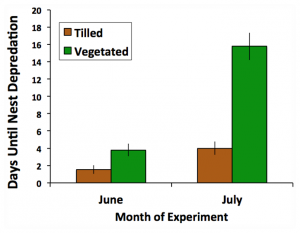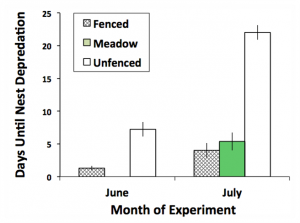Marshall Pregnall (Biology)
The ERI has funded student field work, led by Marshall Pregnall (Biology) for several years in a long-term study of populations of endangered Blanding’s turtles. One of the last remnant populations in the area of a species once widespread in this region, this group of turtles has been radio-tagged and monitored during nesting season for over 15 years. When located, Blanding’s turtles in the wetlands behind Arlington High School are tagged, measured, weighed, and examined for signs of injury.
Due to the vulnerability of the population, it is important to monitor Blanding’s turtle reproduction. Turtle nests are at risk of depredation, and when Blanding’s turtles are observed digging and laying a nest, cages can be placed over the site to protect it. Understanding depredation of nests was a part of a recent project.
 Turtles preferred digging nests in tilled sites due to looser soil, but vegetated sites offer more protection from predators. Vegetated sites were able to remain undisturbed for a longer period of time, which is crucial to the survival of turtle eggs.
Turtles preferred digging nests in tilled sites due to looser soil, but vegetated sites offer more protection from predators. Vegetated sites were able to remain undisturbed for a longer period of time, which is crucial to the survival of turtle eggs.
Fencing, which is meant to protect turtles from wandering onto athletic fields, may also be making them more vulnerable to nest depredation. Turtles emerge from the wetland, looking for warm places to lay their nests. Upon encountering the fence, many go no further, and dig their nests near the fence boundary. Unfortunately, this concentrates nest sites in a pattern that is easy for predators to follow and exploit.
Other turtles live in the wetland: painted turtles, and snapping turtles. All of these turtles lay nests, and, unless turtles are seen while nesting, there is currently no certain way of knowing which nests belong to which species. A current research question is whether there are chemical techniques for distinguishing between nest types.

